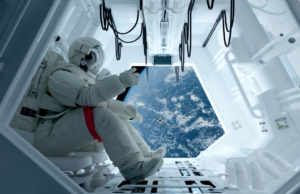The Future of Space Tourism
Where we are now

The idea of Space Tourism feels like something out of a futuristic sci-fi film but the reality is that it’s been around for almost 20 years. Some may recall American businessman, Dennis Tito, becoming the first civilian tourist to visit the International Space Station in 2001. Tito’s trip to space cost him a colossal 20 million dollars, meaning at that price, going into space would remain a dream only to be experienced through films and stories for most of us.
The concept of space tourism evokes a sense of awe and wonder, igniting excitement and fascination within us. This burgeoning industry has gained momentum in recent years, and for valid reasons. For generations, the idea of journeying beyond the confines of Earth’s atmosphere into the boundless expanse of space has captivated the human imagination. With recent technological progress, this aspiration is no longer limited to astronauts and scientists alone, and the prospect of it is enough to entice anyone.
A 20 million dollar space holiday?
Space tourism may seem like a luxury only afforded by the super-rich, but it’s not just about money. It’s an opportunity for anyone to experience something truly unique, awe-inspiring and life-changing. The appeal of space tourism is undeniable, a chance to see the world from a completely different perspective, to feel weightlessness and witness the beauty of our planet from a distance.
According to recent surveys, interest in space tourism is not limited to the wealthy, with 38% of luxury travellers expressing interest in taking a space flight for recreational purposes. Among luxury travellers aged 16-34, that figure rises to an astounding 58%.
The mere thought of space tourism can evoke a sense of wonder and excitement. For many, it’s a chance to realise childhood dreams and experience something that was once unimaginable. It’s a chance to leave behind the mundane and experience the extraordinary. The possibilities of space tourism are endless, from suborbital flights to orbital flights, to staying in space hotels and even commercial space stations.
In this article, we will delve into the world of space tourism, exploring its history, current state, key players and what the future may hold. We will discuss the benefits and challenges of space tourism, its impact on society and the economy, and the ethical and environmental concerns that come with it. So, buckle up and prepare for lift-off as we embark on a journey to the final frontier.
The Space Tourism Market
 Space tourism is an industry that has been growing rapidly in recent years, with the potential to become one of the most lucrative industries in the world. While the industry is still in its infancy, the demand for space travel is growing, and it is expected to continue to expand at a annual growth rate of 40.2% from 2023 to 2030. In 2022, the global space tourism market was valued at USD 695.1 million, and it is projected to reach USD 8,669.2 million by 2030.
Space tourism is an industry that has been growing rapidly in recent years, with the potential to become one of the most lucrative industries in the world. While the industry is still in its infancy, the demand for space travel is growing, and it is expected to continue to expand at a annual growth rate of 40.2% from 2023 to 2030. In 2022, the global space tourism market was valued at USD 695.1 million, and it is projected to reach USD 8,669.2 million by 2030.
The government end-user segment is also expected to grow at a CAGR of 37% from 2022 to 2030. In the United States, North America led the overall market in 2022, with a market share of 38.6%. The region has a well-established infrastructure that has allowed for the speedier implementation of modern technologies, and the presence of an extensive research and development base.
There are two types of space tourism: sub-orbital and orbital.
Suborbital Spaceflight
The sub-orbital segment dominated the market in 2022, accounting for 49.3% of the overall market share and aims to reach an altitude of over 300,000 feet, reaching the Karman line, which is the benchmark to define where outer space begins. Currently there are two major players competing in this field, Virgin Galactic, part of Richard Branson’s empire and Blue Origin, run by Amazon’s billionaire founder Jeff Bezos. Both of the companies’ systems are rocket-powered and capable of carrying up to six passengers on a flight. Virgin has completed four successful flights however recently filed for bankruptcy after failing to find funding, Blue origin however has now flown 32 passengers on the New Sheppard alongside a number of uncrewed flights carrying payloads onboard.
Orbital Spaceflight
Unlike suborbital spaceflight which gives passengers a few minutes in space at an altitude of 300,000 feet, orbital spaceflight goes much further than this. Passengers are likely to spend between a few days in space up to over a week at an altitude of over 1.3 million feet. The final quarter of 2021 is likely to be a huge for tourists in orbital spaceflight, with two major companies Space Adventures and Axiom Space announcing up to nine seats to orbit available for purchase by either individuals or organizations.
The sub-orbital segment dominated the market in 2022, accounting for 49.3% of the overall market share. The orbital segment, on the other hand, is expected to witness the fastest growth of 41.0% throughout the forecast period. The demand for space tourism is expected to continue to grow in the coming years, as the cost of space travel decreases and more people become interested in the experience.
Current Space Tourism Competitors and Missions
Whilst still relatively new the space tourism industry already has several key players:
- SpaceX
- Blue Origin
- Orion Span
- Boeing
- Zero-G
- Space Adventure
- Zero 2 Infinity
- World View
- Space Perspective
- Nanoracks
- Axiom
These companies are working to develop new technologies and services that will make space travel more accessible and affordable for a broader market.
 In 2021, entrepreneur Jared Isaacman organized the Inspiration4 mission, the world’s first all-civilian mission, which demonstrated the growing interest in space tourism. This mission was a significant step towards making space travel more accessible to the general public, being that there were no professional astronauts onboard.
In 2021, entrepreneur Jared Isaacman organized the Inspiration4 mission, the world’s first all-civilian mission, which demonstrated the growing interest in space tourism. This mission was a significant step towards making space travel more accessible to the general public, being that there were no professional astronauts onboard.
More recently NASA funded three companies to develop commercial space stations, totaling $415M. Blue Origin received $130 million, Nanoracks received $160 million, and Northrop Grumman Systems Corporation received $125.6 million. These developments help support growing demand for space tourism, providing the necessary infrastructure to support it.
Where is Space Tourism Booming?
North America is leading the way in the space tourism market, with a well-established infrastructure and an extensive research and development base. Europe, although behind America in the market, is also showing potential in the space tourism industry, with the U.K. government pledging £2 million to fund horizontal space launches from the country. The U.K. has emerged as a region leader for spaceports, which could then transition into more opportunities for space tourism in Europe. However, the COVID-19 pandemic and the war in Ukraine have been detrimental to building the European space tourism market, with space activities and funding being diverted elsewhere. To keep up with the US, Europe needs to scale launch capabilities
Why is Space Tourism expected to be so popular?
 Space tourism is becoming more popular because it offers an entirely new and unique experience that cannot be found on Earth. While traditional luxury holidays on Earth may offer relaxation and entertainment, space tourism offers a transformative experience that can change a person’s perspective and understanding of the world.
Space tourism is becoming more popular because it offers an entirely new and unique experience that cannot be found on Earth. While traditional luxury holidays on Earth may offer relaxation and entertainment, space tourism offers a transformative experience that can change a person’s perspective and understanding of the world.
Going to space provides an opportunity to witness the beauty of the Earth from a completely different perspective. It allows one to see the planet as a whole, and to appreciate the fragile and interconnected nature of all life on Earth. The experience of weightlessness and the sensation of floating in space is also something that very few people have ever experienced, which makes it an incredible and unforgettable experience.
Choosing to go to space over an expensive holiday on Earth is a personal decision, but it offers a once-in-a-lifetime experience that cannot be replicated elsewhere. It provides an opportunity to break free from the monotony of everyday life and to embark on a truly unique adventure that can inspire personal growth and self-discovery. Furthermore, it offers an opportunity to contribute to the advancement of space exploration, science, and technology, which has the potential to benefit all of humanity in the long run.
But space tourism is not without its challenges…
While space tourism offers exciting opportunities, there are also some potential drawbacks and negative effects to consider.
Environmental Impact: Space tourism can have a negative impact on the environment. Launching spacecraft and rockets require a lot of energy and can produce significant amounts of air and noise pollution. These emissions can contribute to climate change and harm the atmosphere.
Safety Concerns: Space travel is still a dangerous endeavor, and accidents can happen. Despite safety protocols, there is always the risk of something going wrong, and the consequences of a mishap could be catastrophic.
Cost: At present, space tourism is an expensive venture that is accessible only to the wealthy. As a result, many people will not be able to experience space travel, which can create feelings of inequality and elitism.
Space Debris: Every launch of a spacecraft generates debris that can stay in orbit for many years, and as the number of space launches increases, the amount of debris grows. This debris can cause problems for other spacecraft, and even small debris can cause damage.
Resource Depletion: Space travel requires a vast amount of resources, including energy, fuel, and materials. The depletion of these resources could have long-term consequences and could negatively impact the environment and the availability of resources for future generations.
Legal Issues: The legal framework for space tourism is still evolving, and it is unclear who will be held responsible if something goes wrong. There are also concerns about the impact of space tourism on international space laws and treaties.
The industry must ensure safety and sustainability, avoiding the mistakes of the past and building a foundation for the future. Including continuing to invest in research and development and ensuring that space travel becomes more accessible and affordable for all.
So What’s Next?
Space Hotels
 Whilst we may be closer to achieving regular space travel and a booming space tourism industry but what’s next?
Whilst we may be closer to achieving regular space travel and a booming space tourism industry but what’s next?
Plans involving orbital spaceflight will require tourists to stay at the International Space Station, the only habitable structure in space at the moment but many companies are looking beyond this. Space hotels are likely to be the next venture for many to support the space tourism sector. One company, Orion Span, has developed plans for the first-ever “affordable” luxury space hotel called ‘Aurora station’. Orion Span is looking to launch in 2021 and start welcoming guests in 2022. This doesn’t mean the opportunity will be available to many of us with the expected cost of a 12-day stay on the ‘Aurora station’ coming to $9.5 million, quite literally a price that’s out of this world. Still, that’s a lot less than orbital tourists have paid in the past, as all of the seven private citizens that took trips to ISS each payed an estimated $20 million to $40 million per trip.
One small step for hotels… one giant leap for hotel life. Not only are space companies looking to venture into space hotels but giant hotel booking company Hotels.com. Launching the first online travel site, ‘offering future hotel bookings in space and reward earthlings with the ultimate out of this world travel escape’. Featuring space robes and slippers, intergalactic room service, solar lobbies, holographic wake-up calls, meteor mini bar, zero gravity space deck, pool and bar, which have all been imagined through beautiful renders of a space hotel on their galactic booking website.
Whilst space hotels like this may be a long way off until then there’s plenty of options to have an out of this world experience in one of these space themed hotels. Here’s our top five:
Top 5 Space Theme Hotels on Earth
 The Space Odyssey Suite at Sunset Inn & Suites, Clinton, Illinois, USA
The Space Odyssey Suite at Sunset Inn & Suites, Clinton, Illinois, USA
The website says : Experience the feeling of flying among the stars as you enjoy the comfort of your Serenity Latex Mattress, specially designed for your spaceship bed. The triangular whirlpool bath glows softly under the stars from a multitude of different galaxies as you enjoy watching movies on your Plasma Screen Television. The DVD provided ensures you can watch all the Star Wars movies you’re able to while staying with us.
The steam shower is equipped with the “Raindancer Shower” which is almost as good as having a masseuse in the room with you. Your wet bar comes complete with a microwave, refrigerator and coffeemaker so you will not have to leave your spaceship until you are done exploring the universe and are ready to return to Earth! Your mission, should you decide to accept it, is to enjoy your outer space experience and boldly go where no others have gone before.
Outer space room with Seaview balcony at Gold Coast Hotel, Hong Kong
The website says: Journey to a different galaxy in the Outer Space Room, where different planets hang from a ceiling of stars and a full space mural encourages a voyage for both the young and the young at heart. Little guests can sleep and play in their miniature bed, while adults can seek much-deserved rest in a giant crater bed.
Fantasy Land Hotel, Edmonton, Alberta, Canada
The website says: 5, 4, 3, 2, 1, Blast-off! Explore the universe in our new Space Theme room and enjoy the amenities.
Pengheng Space Capsules Hotel, Shenzhen, China
Offering what is likely the most of the this world experience, this hotel pushes the boundaries of design and futurism. This exciting space themed hotel has done away with rooms and features a sleeping capsule mimicking life in space. Not only this, the hotel is staffed entirely by robots so maybe the designs fromHotel.com aren’t so farfetched after all!
The Executive suite at the Kameha Grand Zurich Hotel, Switzerland